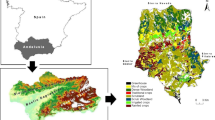Abstract
Background, aim, and scope
Atrazine (2-chloro-4-ethylamino-6-isopropylamino-1,3,5-triazine) is one of the most widely used herbicides for broadleaf weed and certain annual grass controls and is popular because of its effectiveness and low cost. Losses of atrazine from agricultural lands into adjacent surface water and underlying groundwater have raised public concerns. Several computer models have been developed for atrazine runoff in watersheds. One limitation for most of these models, however, is that vast amounts of input parameters are required for simulations. These input parameters are sometimes difficult to obtain through the experimental measurements for model calibrations, validations, and applications. Therefore, a need exists to develop a simple and yet a realistic modeling tool that can be used for effectively investigating atrazine dynamics in agricultural soils. This study was designed to meet this need.
Materials and methods
A model was developed based on atrazine dynamics in agricultural soils. These dynamics include atrazine (1) application to soil, (2) loss from surface runoff, (3) volatilization, (4) sorption, (5) degradation, (6) root uptake, and (7) leaching. The model was constructed using the commercially available package Structural Thinking, Experiential Learning Laboratory with Animation (STELLA) and calibrated using field data prior to its applications.
Results and discussion
A simulation scenario was then performed to predict atrazine fate in a 1-ha field. Simulation results showed that atrazine runoff and leaching occurred within the first coupled rainfall events with a duration of about 40 days after its application to the soil. This occurred because atrazine was strongly adsorbed by the soil in addition to its degradation by soil microorganisms, volatilization to the atmosphere, and uptake by roots. The maximum adsorption rate of atrazine was found in 1 day and reached an equilibrium condition in about 100 days. Two degradation phases, namely, the fast and slow phases, were observed in this simulation. The fast degradation phase occurred within 1 week after atrazine application, whereas the slow degradation phase took place after 1 week of the atrazine application. About 25% of the total applied atrazine still remained in the soil at the end of the simulation period (120 days). Of which, almost all of them were retained in the solid phase.
Conclusions
A very good agreement was obtained between the model predictions and the field measurements. The model was quite successfully applied to predict the complex behaviors of atrazine in the soil.
Recommendations and perspectives
This study suggests that the model, developed with STELLA, has great potentials as a modeling tool for effective investigations of atrazine dynamics in agricultural soils due to its being simple and yet realistic.







Similar content being viewed by others
References
Aassine S, El Jai MC (2002) Vegetation dynamics modelling: a method for coupling local and space dynamics. Ecol Model 154:237–249
Bengtson RL, Selim HM, Ricaud R (1998) Water quality from sugarcane production on alluvial soils. Trans ASAE 41:1331–1336
Correia FV, Macrae A, Guilherme LRG, Langenbach T (2007) Atrazine sorption and fate in a Ultisol from humid tropical Brazil. Chemosphere 67:847–854
Costanza R, Voinov A, Boumans R, Maxwell T, Villa F, Voinov H, Wainger L (2002) Integrated ecological economic modeling of the Patuxent river watershed, Maryland. Ecol Monogr 72:203–231
Gerakis A, Ritchie JT (1998) Simulation of atrazine leaching in relation to water-table management using the CERES model. J Environ Manag 52:241–258
Hannon B, Ruth M (1994) Dynamic modeling. Springer, New York
Isee Systems (2006) Technical document for the iThink and STELLA software. http://www.iseesystems.com
Isensee AR, Nash RG, Helling CS (1990) Effect of conventional vs. no-tillage on pesticide leaching to shallow ground-water. J Environ Qual 19:434–440
Larose M, Heathman GC, Norton LD, Engel B (2007) Hydrologic and atrazine simulation of the Cedar Creek watershed using the SWAT model. J Environ Qual 36:521–531
Ma QL, Wauchope RD, Ma LW, Rojas KW, Malone RW, Ahuja LR (2004) Test of the root zone water quality model (RZWQM) for predicting runoff of atrazine, alachlor and fenamiphos species from conventional-tillage corn mesoplots. Pest Manag Sci 60:267–276
Maidment DR (1993) Handbook of hydrology. McGraw-Hill, New York
Mbuya OS, Nkedi-Kizza P, Boote KJ (2001) Fate of atrazine in sandy soil cropped with sorghum. J Environ Qual 30:71–77
Mullins JA, Carsel RF, Scarbrough JE, Ivery AM (1993) PRZM-2, a model for predicting pesticides fate in the crop root and unsaturated soil zones: user manual for release 2.0. USEPA, Athens, GA
Neitsch SL, Arnold JG, Kiniry JR, Srinivasan R, Williams JR (2002) Soil and water assessment tool user's manual, version 2000. GSWRL Report 02-02, BRC Report 02-06. Texas Water Resources Institute TR-192, College Station, TX
Ouyang Y (2008) Modeling the mechanisms for uptake and translocation of dioxane in a soil–plant ecosystem with STELLA. J Contam Hydrol 95:17–29
Peterson S, Richmond B (1996) STELLA research technical documentation. High Performance Systems, Hanover, NH
Selim HM (2003) Retention and runoff losses of atrazine and metribuzin in soil. J Environ Qual 32:1058–1071
Wehtje G, Mielke LN, Leavit JRC, Schepers JS (1984) Leaching of atrazine in the root zone of an alluvial soil in Nebraska. J Environ Qual 13:507–513
Author information
Authors and Affiliations
Corresponding author
Additional information
Responsible editor: Jianming Xu
Rights and permissions
About this article
Cite this article
Ouyang, Y., Zhang, J.E., Lin, D. et al. A STELLA model for the estimation of atrazine runoff, leaching, adsorption, and degradation from an agricultural land. J Soils Sediments 10, 263–271 (2010). https://doi.org/10.1007/s11368-009-0107-8
Received:
Accepted:
Published:
Issue Date:
DOI: https://doi.org/10.1007/s11368-009-0107-8




